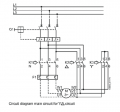Hello Everyone,
I'm currently working on a project where I aim to remotely control a 3-phase 22kW water pump motor using an Arduino microcontroller. To achieve this, I'm considering using relays as ON/OFF switches between the Arduino and a contactor that will ultimately control the motor.
However, I'm seeking some expert advice on whether this setup is feasible and, if so, what type of relay would be suitable for this application. Specifically, I'm interested in knowing:
1. Can I use relays to act as ON/OFF switches between an Arduino and a contactor that controls a 3-phase 22kW water pump motor?
2. If yes, what type of relay should I use for this purpose? Are there any specific specifications or features I should look for in the relay to ensure compatibility and safety?
3. If using relays is not advisable for this application, what alternative solutions or components would you recommend for achieving remote control of the water pump motor with an Arduino?
I would greatly appreciate any insights, recommendations, or experiences you can share on this topic. Your expertise would be invaluable in helping me move forward with my project.
Thank you very much for your time and assistance.
Best regards,
Aravindan
I'm currently working on a project where I aim to remotely control a 3-phase 22kW water pump motor using an Arduino microcontroller. To achieve this, I'm considering using relays as ON/OFF switches between the Arduino and a contactor that will ultimately control the motor.
However, I'm seeking some expert advice on whether this setup is feasible and, if so, what type of relay would be suitable for this application. Specifically, I'm interested in knowing:
1. Can I use relays to act as ON/OFF switches between an Arduino and a contactor that controls a 3-phase 22kW water pump motor?
2. If yes, what type of relay should I use for this purpose? Are there any specific specifications or features I should look for in the relay to ensure compatibility and safety?
3. If using relays is not advisable for this application, what alternative solutions or components would you recommend for achieving remote control of the water pump motor with an Arduino?
I would greatly appreciate any insights, recommendations, or experiences you can share on this topic. Your expertise would be invaluable in helping me move forward with my project.
Thank you very much for your time and assistance.
Best regards,
Aravindan






